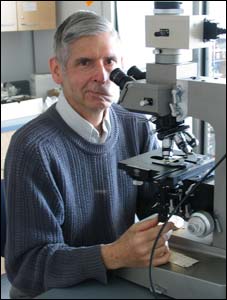Diatoms: Patrick Eggleston Studies 'Jewels of the River'

KEENE, N.H. 5/4/05 - You have to be willing to splash around in rivers just to collect them, and you need a microscope to see them. According to Patrick Eggleston, professor of biology, it’s worth the effort.
Diatoms are microscopic single-celled algae that abound in rivers and oceans. One of their functions in nature is to remove large amounts of a major greenhouse gas - carbon dioxide - from the atmosphere. Diatoms are also indicator species: By studying variables such as the number of species found at particular sites in a river, scientists can determine the health of the ecosystem. But scientists also study diatoms for their intricate design.
The cell walls of the tiny organisms are made of silica, the main component of glass. The cell walls, or shells, are intricately patterned by features only a few micrometers (a micrometer is one millionth of a meter) in size. Each of the 6,000 or so known species of diatoms has a unique pattern on its shell, which helps in its identification. The species Pinnularia interrupta resembles a rolling pin; _Eunotia serra tetradon _looks like a comb.
Scientists have long been struck by the beauty of these organisms, which are sometimes nicknamed “jewels” of the river or sea. Since microscope photography was invented, scientists have collected images of diatoms for artistic purposes as much as science.
So far, Patrick has identified 127 species of diatoms in the river, many of which he has photographed using a research microscope camera. His work recently received national attention when his photograph of the species _Eunotia serra _was one of 16 published on the cover of the January 2005 issue of the Journal of Nanoscience and Nanotechnology.
Patrick has studied diatoms since graduate school. “To me, they’re addictive,” he says. He collects diatoms from sites along the Ashuelot River, taking scrapings from rocks and stashing the samples in vials. The samples are transferred onto slides and slid under a microscope, ready for counting and identification. With up to 10,000 diatoms on a slide, counting can take a while, he says. When he comes across a diatom that he hasn’t seen before, it can take hours to figure out what it is. The attraction, he says, is the unknown. “You never know what’s around the corner. Once in a while I’ll find something I’ve never seen before.”
Patrick is reasonably sure that two of the diatoms he’s found in the Ashuelot are new species, but this needs to be verified by other scientists before he can publish his findings. He also has a growing body of data on how different contaminants may affect diatoms, thus providing an indication of the health of the river.





